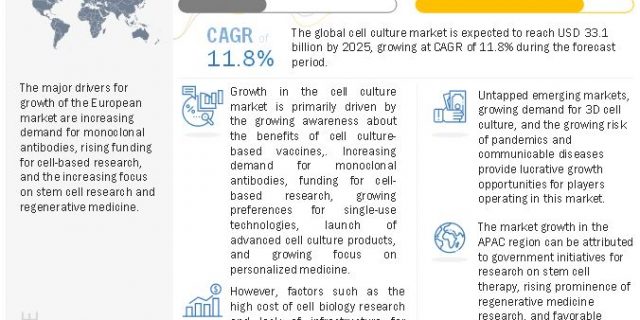
Market Overview and Growth Drivers:
The cell culture market is projected to reach USD 33.1 billion by 2025 from USD 19.0 billion in 2020, at a CAGR of 11.8% during the forecast period. The growth of this market is majorly driven by the growing awareness about the benefits of cell culture-based vaccines, increasing demand for monoclonal antibodies (mAbs), funding for cell-based research, growing preference for single-use technologies, and the launch of advanced cell culture products.
Download PDF Brochure: https://www.marketsandmarkets.com/pdfdownloadNew.asp?id=559
The growing demand for 3D cell culture, the growing risks of pandemics and communicable diseases, and emerging markets are expected to offer significant growth opportunities for the players operating in the global Cell culture market. On the other hand, the high cost of cell biology research and the lack of proper infrastructure for cell-based research activities are the major factors restraining this market’s growth.
Key Leading Players : Cell Culture Market
- Thermo Fisher Scientific is one of the leading players in the cell culture market. The leading position of the company can be attributed to its established brands such as Gibco, Nunc, Countess, Mr. Frosty, Dynabeads, and Lipofectamine and the company’s robust product portfolio for cell culture. To maintain its leading position in the cell culture market, the company adopts organic and inorganic growth strategies such as new product launches, expansions, and acquisitions. In November 2019, Thermo Fisher Scientific invested USD 24 million in its Inchinnan, Scotland, site to expand global bioproduction capabilities with additional large volume liquid manufacturing capacity for cell culture media. The company focuses on investing in R&D activities to launch new and advanced products. For instance, in 2018, the company launched the Cell Locker system, the Cloud-Enabled Biological Safety Cabinet, and its Invitrogen EVOS M7000 microscope. Thermo Fisher’s efforts towards enhancing its product portfolio have significantly helped the company establish its leading position in the cell culture market
- Merck KGaA (Germany) was the second-largest player in the cell culture market in 2019. The company has a strong portfolio of cell culture products, including cell culture equipment, cell culture media, reagents, and sera. In order to maintain its strong position in the market, the company focuses on adopting organic as well as inorganic growth strategies such as acquisitions and new product launches. The company’s focus on inorganic growth strategies is evident from its recent (March 2019) collaboration with GenScript (China) to fast-track the commercialization of cell & gene therapy platform by building a global-standard platform for plasmid and virus manufacturing in China. Furthermore, Merck has a well-organized supply chain that delivers standard products in 24 to 48 hours worldwide. The company focuses on new product launches in order to leverage growth opportunities in the cell culture market. Some of its recent launches include CellStream benchtop flow cytometry system (April 2018), Viresolve Barrier capsule filters to reduce the risk of bioreactor contamination (February 2018), EX-CELL Advanced HD Perfusion Medium (May 2017), and Millistak+ HC Pro (September 2017), among others. Such developments help in expanding Merck’s presence in the cell culture market, thus maintaining its leading position.
- GE Healthcare (US) was the third-largest player in the cell culture market in 2019. The company has an exhaustive product portfolio, which includes classical media, specialty media, calf sera, FBS, FBS alternatives, specialty sera, other sera, reagents & supplements, balanced salts, and buffers. GE Healthcare focuses on adopting organic and inorganic business strategies. In May 2018, GE Healthcare- Cytiva increased its annual production capacity of powdered cell culture media by tenfold. This development strengthened the product supply for biopharmaceutical companies in Europe. The company also doubled its powdered cell culture media manufacturing capacity in the US. In November 2017, GE Healthcare (US) acquired Puridify (UK). This acquisition helped GE Healthcare to enhance its production of biopharmaceuticals. Such acquisitions help strengthen the company’s product offerings in the cell culture market. GE Healthcare also focuses on strategies such as collaborations and partnerships to enhance and maintain its market position. For instance, in July 2017, GE partnered with Oritain (New Zealand) to launch an independent test-based traceability program to validate the country of origin of the Fetal Bovine Serum (FBS).
Recent Developments
- In October 2020, Eppendorf (Germany) launched Refrigerated Centrifuge 5425 R
- In September 2020, Thermo Fisher Scientific (US) opened a new bioprocessing collaboration center in St. Louis, Missouri, US.
- In September 2020, Cytiva plans to increase its manufacturing capacity with an investment of USD 500 million.
- In April 2020, Danaher Corporation completed the acquisition of GE Healthcare’s biopharma business. Under Danaher’s ownership, the business will be called Cytiva.
Request Sample Pages: https://www.marketsandmarkets.com/requestsampleNew.asp?id=559
North America was the largest regional market for cell culture in 2018
By region, the cell culture market is segmented into North America, Europe, the Asia Pacific, and the Rest of the World (RoW). In 2018, North America accounted for the largest market share, followed by Europe. The growing regulatory approvals for cell culture-based vaccines, rising incidence of diseases such as cancer, strong government support, and conferences and symposiums that create awareness on the latest trends in cell culture technology are the key factors driving the growth of the cell culture market in North America.

